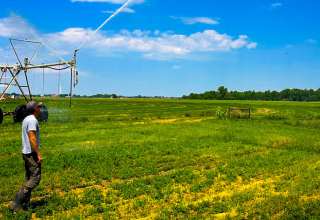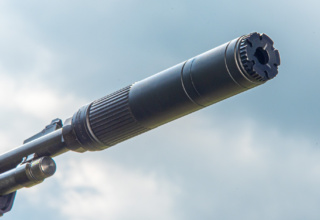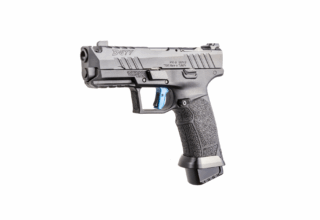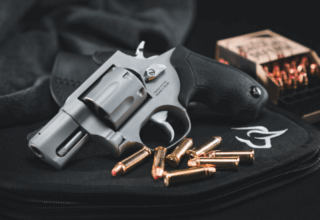We challenge Dryshod’s newest waterproof boots in the southern swaps and the Appalachian highlands. Yep, these dogs hunt…
by Rob Reaser
“What are all these boots for?” my wife occasionally asks when too many of my muddy foot soldiers end up stretched across the front porch.
I often find it to be an odd question, coming from someone who has graced the back of our bedroom door with a top-to-bottom shoe rack full of assorted footwear. I cautiously reference her own stash of shoes while explaining that every boot on the porch has its time and purpose. Fortunately, she understands and suggests putting the boots I don’t use “as often” in the house somewhere out of the way.
Fair enough.
Over the last several weeks, my case for having a porch full of boots has weakened somewhat with the introduction of my latest pair from the folks at Dryshod. I received a pair of the company’s Overland waterproof boots prior to a hunting trip to central Alabama and have been wearing them exclusively ever since.
If you’ve never heard of Dryshod before, you’re not alone. Our introduction to the company came at this year’s Archery Trade Association show. Turns out, although the company is fresh, the brains behind the products have quite the history in developing waterproof boots for hunting, outdoor recreation, and work. They were the first to develop the bootie-style neoprene/rubber waterproof boot design, which was a HUGE leap for sportsmen tired of wearing those heavy, awkward, and often aggravating all-rubber boots most of us grew up with. Now, those same designers have formed a new company and have worked diligently to bring new technology and design innovations to the waterproof neoprene/rubber boot category under the Dryshod banner.
Our first experience with the Dryshod brand came when we received a pair of their Overland Hi outdoor boots to wear on a squirrel hunt in the heart of Dixie.
Unlike leather-upper hunting boots, neoprene/rubber boots don’t require “breaking in” because their pliable, return-to-form construction means they never get out of shape. Still, I always prefer to wear new hunting boots for a few weeks prior to a hunt so I can get used to them and discover what sock combinations work the best. I decided to not do that with the Dryshod Overlands because there is no better way to test boot comfort and performance than trial by fire.
My trial for the Overlands involved fast-stepping through the thick central Alabama hardwoods replete with swampy bottoms, steep hillsides, and deep creek channels while trying to keep up with a brace of mountain curs intent on finding us squirrels. Other than trying them on for fit, I never wore the Overlands until the hunt began. A risky proposition, I knew, but one that would provide a solid evaluation.
I discovered right away that I had made a mistake.

I learned long ago that nothing works better to keep feet dry, warm, and blister-free than wearing a pair of thin polypropylene liner socks beneath a pair of merino wool blend socks. Liner socks help wick moisture away from the skin and reduce or eliminate the friction responsible for blisters. In my haste to pack for this trip, I had totally forgotten my liner socks and was rightly concerned that this oversight was going to deal me a set of blisters that would make day two of the hunt absolutely miserable.

Imagine my delight when, at the end of a hard day of hunting and who knows how many miles of chasing those excitable curs, the Dryshod Overlands produced not a single blister even though I had never worn the boots before and had forgotten my poly socks.
Score one for the Dryshod Overlands in the comfort category.
I also noticed that the Overlands did not encourage moisture buildup like my other neoprene/rubber boots. Usually, my socks and pant legs are thoroughly soaked from sweat after just a few hours of walking when wearing my old boots. Not so with the Overlands. Yes, my socks and cotton pant legs were slightly damp to the touch but nowhere near as soggy as I’m used to experiencing. I found that rather surprising since Dryshod makes their neoprene booties from 5mm Densoprene foam, which is a bit thicker than that of my other boots.

The difference, I assume, is the 4-way stretch airmesh lining inside the bootie. This is a two-layer mesh that is separated by tiny, vertical microfibers. The idea is that the microfibers allow air to pass easily through the airmesh structure to promote insulation as well as prevent moisture buildup.
I admit to being skeptical of this technology at first, but there was no denying that my socks and pant legs were significantly drier after two days of hard walking in T-shirt weather than they would have been had I been wearing my standard rubber or rubber/neoprene waterproof boots.

Score one for the Dryshod Overlands in the breathability category.
Ask anyone I hunt with and they will tell you that conventional boot tread, or outsole, designs and composition is my biggest peeve. It seems that 99 percent of the boots I look at these days consist of ridiculous tread patterns that seem purposely designed to reduce rather than to enhance traction. Adding to those poor tread designs is the slick, plasticky outsole material that is quick to ensure your butt meets the ground the instant your foot lands on a wet or lichen-covered rock.

The Overland boot outsoles, fortunately, seem to buck that obnoxious trend. The boot’s DSI molded outsole is exceptionally aggressive, with large tread blocks along the edges that aid in ankle support when walking off-camber terrain and sharp, diamond-shaped tread blocks toward the center. The latter offers generous siping and high void areas between the blocks to provide positive grip on all soils and ground cover. Between the voids are pointed nubs that further enhance traction.
I have become so disillusioned with boot treads over the years that I expected only more of the same from the Overland. I wrong. An insane amount of rain had hit central Alabama prior to our hunt, so there was plenty of slippery and soggy terrain to evaluate the Overland’s tractability. I found these boots capable of biting into steep hillsides, leaf-covered slopes, wet rocks, mud, rotten logs, and anything else we hunters encounter every time we hit the woods.
Five gold stars for the Dryshod Overland’s traction performance.
Dryshod may be a new name on the waterproof hunting and outdoor recreation boot roster, but if our experience with the Dryshod Overland model is any indication, you’ll be hearing a lot more about this company’s products in the coming months.


















